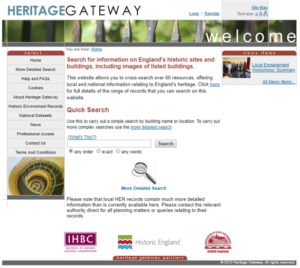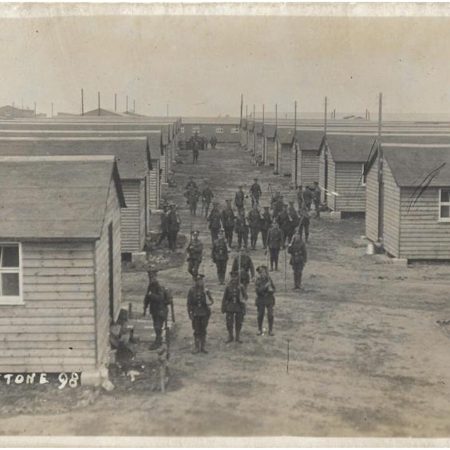When you think of the First World War often the first thing to spring to mind are trenches and fighting in France and Belgium. However, the war had a huge impact on the landscapes, buildings, and people at home.
The army requisitioned acres of land to build training camps and provide areas for the newly formed battalions to train for their upcoming deployment to the front. The government requisitioned hundreds of civilian factories to produce war material, such as shells, bullets, uniforms, boots, aircraft components, and any other equipment that was required for the war effort. Hospitals to treat wounded soldiers were established in stately homes, large town houses, schools, and town halls. The First World War saw the UK come under attack from the air. Air ships and fixed wing aircraft dropped thousands of bombs throughout the country, destroying and damaging many buildings. The military reacted to these raids by establishing an air defence network consisting of observer posts, listening stations, anti-aircraft guns and Home Defence airfields.
After the war, many of these sites were no longer required. The training camps were dismantled, their accommodation huts sold to be used elsewhere and the land returned to farmland. The requisitioned factories producing war materiel went back to producing items for the civilian market. The hospitals returned to being stately homes, schools, and town halls. The buildings damaged by air raids were repaired or demolished and the anti-aircraft defences were eventually mothballed.
As a result, the First World War use of many of these sites and buildings remains to be re-discovered and recorded. You can help by finding and recording sites in your local area.
The aim of this blog is to help you discover the surviving First World War Home Front sites in your local area, and how you can help to record such surviving sites.
Getting Started- Sources of Information

Map showing the route of the German Zeppelin L.13 on the night of 28-29 July 1916 © IWM (Q 69351)
Getting started is easy! There are many free sources of information that you can consult from home. Many sites can be re-discovered using internet searches alone.
Keeping Track
Writing notes will help you keep track of the sources of information you have consulted, and will make writing your final record a lot easier. There is nothing more frustrating than losing links to sources of information!
It is recommended to create a simple file to store information relating to a single site. This can include a Word document to store site information, sources, and links, as well as separate folders for any images or documents you wish to attach to your final record.
Home Front Legacy 1914-18 Archive

A good place to start your research into the First World War Home Front is the Council for British Archaeology’s Home Front Legacy 1914-18 database (tinyurl.com/28hn822c) presented on the Archaeology Data Service website.
This archaeological project ran from 2014 to 2018 and involved members of the public recording their local First World War Home Front sites to create an archaeological database of sites to aid their future preservation.
This database, although no longer open to new site submissions, is free to browse and may give you an insight into First World War Home Front sites in your local area, so do check it out.
The Historic Environment Record and National Monuments Record
As mentioned, the Home Front Legacy 1914-18 database is now closed and will not be edited or updated in the future. But you can send records to your local Historic Environment Record to record your discoveries.

Heritage Gateway (tinyurl.com/y9cvfk6a) can also be used to find known First World War sites within Historic Environment Records (HERs) and the National Monuments Record. You should aim to further research the sites you find via Heritage Gateway to find additional information. Adding additional information to existing records is extremely important as it helps us to better understand a site and its history.
Contacting your local Historic Environment Record (HER) is recommended and may point you towards local sites that require more investigation.
Be sure to make a note of any HER/NMR reference numbers as these will need to be recorded later.
You will also need to make sure that any sites you find are recorded with your local Historic Environment Record.
Web searches
Web searches are the quickest and easiest way of finding sites to record. A Google search may reveal blogs, websites and documents that provide useful information.
Search terms such as ‘WW1 in [insert local place]’ or ‘WW1 Hospitals in [Insert local place]’ can quickly reveal local sites you can investigate further and record.
Internet forums are also a useful source of information and can be used to request further information about a specific site.
Remember to keep a note of web addresses as you will need them when using the recording app. Also, record the date you accessed webpages.
Imperial War Museum Website

Photographs of the Home Front are a great primary source of information, often giving an insight into life at home during the First World War. Photographs can also reveal forgotten and unrecorded First World War sites that you can record with your local HER.
The Imperial War Museum’s Collections website (tinyurl.com/y9v37res) is a ready source of images and information. You can quickly search through 1,000s of images held within the IWM’s extensive collection with ease.
You can search freely using any search terms you can think of. Useful search terms include ‘British Home Front 1914-1918’, ‘British War Work 1914-1918’ & ‘Royal Flying Corps and Royal Air Force 1912-1918’, ‘British Army Training 1914-1918’ & ‘The British Army on the Home Front 1914-1918’ See what you can find!
Searches can then be filtered using the ‘Related period’, ‘Themes’ and ‘Associated Places’.
Here are a few examples of Home Front sites discovered through images held in the IWM Collections website-
Camp of the 4th (Newbury) Battalion, Royal Berkshire Regiment, at Newbury Racecourse in October 1914- iwm.org.uk/collections/item/object/205025702 (tinyurl.com/y9al9ojr)
A Mk IV Female Tank on the testing ground at Cricklewood, north-west London- © IWM (Q 14476) iwm.org.uk/collections/item/object/205215597 (tinyurl.com/y8nmjx78)
Exterior of the Royal Army Clothing Department, Swinegate Depot, Leeds- © IWM (Q 28650) iwm.org.uk/collections/item/object/205288964 (tinyurl.com/y9m5uvac)
Once you have found a site further research can be undertaken to gather more information. Web searches should provide you with further information.
Make sure you read the IWM Non-commercial Licence (tinyurl.com/ycc5ea5t) information before using images from the IWM Collections website.
Always record the reference for any images you wish to attach to a record. Using the image reference as the filename when saving images will help you keep track of which images you have used.
Local History books
Local history books can be purchased on-line or accessed for via your local library, archive, or local studies library. You may also find books that focus specifically on the Home Front in your local area.
Regimental histories from the First World War may highlight buildings requisitioned to act as recruitment offices and billets, and may also highlight the location of training camps and training areas.
The sources section of the book may highlight documents held in a local archive which you can scrutinise further.
Be sure to make a note of the book’s title, author, and year of publication.
Postcards

Vintage postcards are an invaluable visual resource for investigating First World War sites, structures, and events; helping to identify the location of sites such as Training Camps, National Factories, Training Areas and Hospitals, as well as buildings hit by bombs during air raids. Postcards show sites ‘as they were’ allowing us to gain an insight into the scale and function of a site and ‘rediscover’ lost sites and forgotten events.
Online auction sites, collectors’ fairs and antiques shops are a good source of postcards, and many can be bought fairly cheaply.
Local Archives and local studies libraries
Your local archive can provide primary sources of information for investigating the local area. Local archive staff may be able to point you in the direction of useful documents which lead to the re-discovery of a site. You will need to register to access the archive, so be sure to contact your local archive to see what documentation you will need to in order to register.
Find your local archive here– www.gov.uk/search-local-archives (tinyurl.com/ycrscudd)
Newspapers from the First World War period offer an easily accessible starting point for your research. Be aware that it can take a long time to trawl the newspaper articles for sites and events, but perseverance will be rewarded. Sources are key, so record the name and date of the newspaper used and be sure to include full references for all documents consulted.
National Library of Scotland maps
You may also want to take a look at some period maps to help narrow down where a site was. The National Library of Scotland (tinyurl.com/bpml987) website features a brilliant application that allows you to view old Ordnance Survey maps. The map layers have been overlaid on top of modern aerial photographs, which makes map regression a doddle.
This makes confirming the location of your site a lot easier.
Outro
So with all that, you should be able to start to investigate the First World War Home Front and start to see what was going on in your local area.

Author: Dr Chris Kolonko
Bio: Chris is an archaeologist with nearly 20 years’ experience of investigating, researching, recording, and interpreting Second World War anti-invasion defences in the UK, with specialisms in both Community Archaeology and the archaeology of the First and Second World War Home Fronts. He is an accredited member of the Chartered Institute for Archaeologists (CIfA), at the Practitioner level, and holds a Bachelor of Science degree in Archaeology from the University of Bradford.
During his career he has provided specialist training courses in the archaeological recording and interpretation of wartime defences on behalf of organisations including the Council for British Archaeology (CBA), English Heritage (Now Historic England), the Nautical Archaeology Society, and Museum of London Archaeology (MOLA). Chris has also provided professional consultation and advice in the preservation of wartime heritage assets to a range of organisations across the UK, including the CBA, several local councils, Historic Environment Records, and Civic Societies. As well as advice to non-profit organisations, individuals, and community groups who are keen to preserve and learn more about their local wartime heritage assets.
During his career he has also worked for several major organisations, including the CBA, as the Project Archaeologist and Officer for the national recording project Home Front Legacy 1914-18, and MOLA’s multi-million pound funded Coastal and Intertidal Zone Archaeological Network (CITiZAN) project, where he worked as both a Senior Community Archaeologist and Project Officer.
In his spare time, Chris develops resources to help others record wartime sites, having established his website in 2015 (chriskolonko.wordpress.com) to share this information. He also frequently liaises with local Historic Environment Records, providing information, site records, and reports, and also provides talks and presentations on various aspects of the wartime Home Front.

